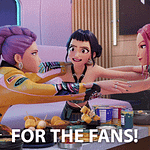See if you can guess who I’m talking about.
The crowd buzzes with anticipation.
A woman in a headset steps onto the stage, raising a hand. Conversations fizzle out.
Then the stomping begins—feet pounding in unison, fists pumping, the chant building.
“JERRY! JERRY! JERRY!”
The stage lights flash, and out he comes, walking that razor-thin line between smug and saintly. The crowd erupts, fully expecting the chaos to follow—flying chairs, family betrayals, and at least one person storming offstage.
It’s ridiculous.
It’s pure spectacle.
But it works.
Even if you never watched his show, you know his name.
This weekend, watching a documentary on Jerry Springer’s legacy, I started thinking: What made his show such a cultural phenomenon?
Was it the relentless shock value?
The predictable format?
Or was there something deeper at play?
Springer’s formula worked—until it didn’t. The pursuit of “more” eventually caught up with the show. And that got me thinking…
Does “more” equal better?
Chefs face this question every time they reach for the butter. More butter makes restaurant food taste better than anything I cook at home—but is more always the answer?
The same temptation exists in content creation.
Turn up the volume.
Spread the butter on thick.
MORE podcasts.
MORE videos.
MORE posts.
But is more actually better?
Or does it just feel that way in the moment?
What did “better” mean for The Jerry Springer show?
For Springer’s producers, “better” didn’t mean higher quality—it meant more. More shock. More controversy. More chaos. More episodes (27 seasons to be exact).
In the documentary, former producers openly admit to the morally questionable ways they fueled the spectacle. The show thrived on airing one outrageous storyline after another, from
"I Married a Horse"
(just as weird as it sounds) to
"Klanfrontation”
(just as racist as it sounds). That episode, featuring new KKK members and neo-Nazis, ended in an all-out riot—*shocker*.
But the ratings? They skyrocketed.
From there, the formula was obvious:
More controversy → More yelling
More yelling → More fights
More fights → Better footage
Better footage → Better ratings
Simply put: violence = better ratings.
Until one love triangle featured on the show ended in second-degree murder. Whoopsie!
If I haven’t spoiled enough for you, watch the Netflix docuseries—it’s totally worth it. But the point is…
What can we learn from trash TV?
Despite the controversy, The Jerry Springer Show wasn’t just mindless chaos—it was a cultural shift. Its impact wasn’t just about the highly emotional guests or WWE-level fights. It changed public perception of what television could be.
Just like I Love Lucy redefined the sitcom, Springer paved the way for the modern era of reality TV. Who knows how tame television would be today without Jerry smashing through the boundaries of socially acceptable entertainment?
For the record, I love The Jerry Springer Show and all of its chaotic descendants. But still, I ask myself—did more episodes of more outrageousness really equal better content?
I guess it depends on whether you consider being voted TV Guide’s #1 Worst TV Show Ever a badge of honor or a warning sign.
What does “better” mean to you?
There’s no shortage of advice on how to crank out more content with AI and automation tools. But I don’t just want to make more—I want to make things better.
As a content chef, how do I go from failing at TikTok recipes to winning the next season of Chopped?
Do we just add butter?
Maybe. But not on everything.
You need:
🏆 Authority — so people trust you
💞 Cultural belonging — so people relate to you
Too much of either:
😒 Feels fake. (Like that Pepsi commercial with Kendal Jenner.)
How to Butter Up Your Content (Without Overdoing It)
So how do we strike the right balance?
High Production Quality
✅ DO — Invest in the final quality of your product to create a thoughtful experience.
❌ DON’T — Buy expensive gear or hire a high-end editor without a content plan to ensure ROI.
High Volume of Touchpoints (Posts, Episodes, Channels)
✅ DO — Engage your audience across multiple touchpoints to build deeper relationships.
❌ DON’T — Stretch yourself thin by chasing every platform before mastering one.
Adding WOW-factor
✅ DO — Inject personality, pizazz, or even a joke to make content memorable.
❌ DON’T — Make it all about you.
Too Much Butter = A Mess
One of the most messy marketing questions I hear is:
“Should we add ______ as a distribution channel?”
Here’s the thing—small teams can’t scale up every distribution channel at once. It’s like using every condiment in your fridge at the same time. What are you making that requires maraschino cherries, kalamata olives, and BBQ sauce?
(Don’t give Jack in the Box any ideas.)
Before jumping on a new platform, ask:
Is there already a community here?
Are people actively searching for your content?
Can you partner with an influencer or leader?
Is this trend sustainable, or will Meta/X copy it tomorrow?
Don’t spread yourself too thin. Focus on where your audience actually is. Otherwise, you’ll be left broke, scrambling, and watching opportunities slip through your butter fingers.
Before I go, here are some things worth your time this week…
Other cool stuff
This is Your Country — If you want to laugh instead of cry at the current state of the world watch this campy, outrageous, and hilarious take on modern-day America. Comedian and Host Tim Dillon calls it a modern day Jerry Springer. Perfect for brain-rotting pleasure.
Notion's Portrait Builder — Finally, a marketing email worth opening. A+ brand interaction, and major brownie points for Notion.
I don’t have much else to say, so I’ll sign off the same way Jerry used to.
“Until next time, take care of yourself and each other.”
Haha okay. Byeeee!

















